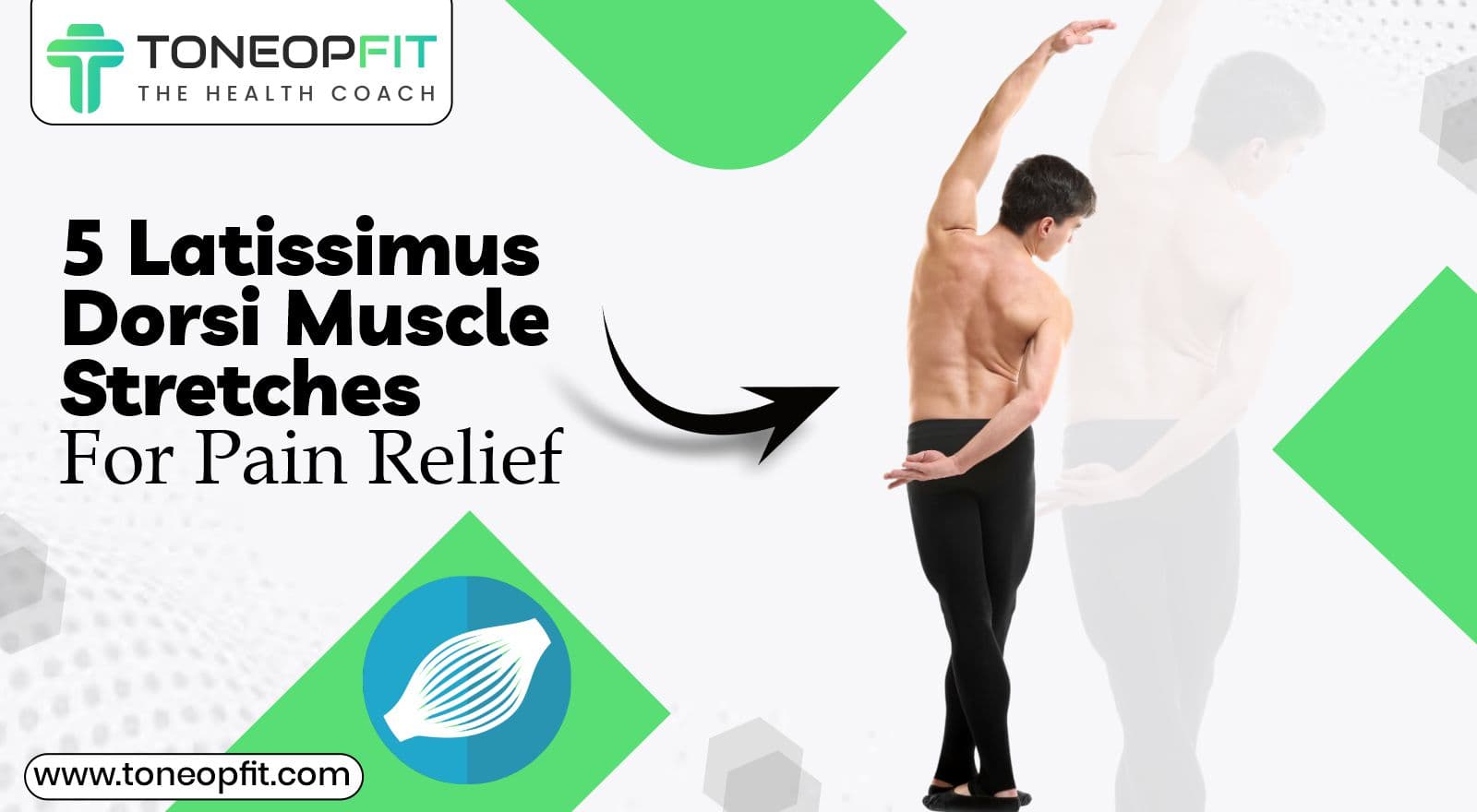The latissimus dorsi, commonly called the "lats," is a large, flat muscle on your back that helps you lift heavy stuff, pull yourself up, and even reach for that snack on the top shelf without doing a full-body stretch. So, if you’re working on a strong, sculpted back, the lats are definitely involved!
However, when doing warm-up exercises or cooling down after a workout, it’s quite common to ignore the lats. This could lead to muscle strain, causing pain in this rear muscle, which would make it difficult to perform daily activities. But there may also be other reasons for pain in the lats.
In this blog, we will discuss the reasons behind the pain in the lats and learn some latissimus dorsi muscle stretches to relieve the pain.
Table of Contents
- 3 Main Causes Behind Tight Latissimus Dorsi
- 5 Latissimus Dorsi Muscle Stretches To Ease Pain In The Lats
- Other Ways To Loosen Tight Latissimus Dorsi Muscles & Relieve Pain
- Expert’s Advice
- The Final Say
- FAQs
- References
3 Main Causes Behind Tight Latissimus Dorsi
Latissimus dorsi muscle pain can strike anyone, but it's especially common among athletes or those who perform repetitive rear movements — like swimmers, rowers, or gym-goers pushing heavy weights.
Whether it’s from an injury, overuse, or just an overworked muscle, the pain can be a real nuisance. Here are three potential causes for latissimus dorsi pain:
| Muscle Strain | More often than not, the latissimus dorsi muscle pain occurs due to excessive strain from sports, especially those that require recurrent upper body movements such as golf, skiing and rowing. This can lead to muscle soreness, fatigue or strain in the lats, which could lead to muscle pain. |
| Muscle Tear | Though this is rarer than tension, it is possible to tear athletes at a high level, such as a gymnast, to tear the latissimus dorsi muscles. Muscle rupture can cause matte pain at rest and intense pain while trying to move. |
| Osteoarthrosis | If you have arthritis, especially osteoarthritis, in the thoracic spine, it can be the reason for pain in your latissimus dorsi. It causes cartilage breakdown in the joints, resulting in inflammation and stiffness in the spine, which can affect nearby muscles like the lats. |
Also Read: Lats Workout At Home: 7 Best Latissimus Dorsi Exercises And Strategies To Build A V-Shaped Back!
5 Latissimus Dorsi Muscle Stretches To Ease Pain In The Lats

Following are the stretches that can help loosen your latissimus dorsi muscles and relieve pain:
1. Lat Dorsi Stretch
- Start this stretching for latissimus dorsi by standing or kneeling with your feet shoulder-width apart.
- Raise one arm overhead and reach for the opposite side, feeling a stretch along the side of your body.
- Keep your arm straight, and gently lean your torso to the opposite side to deepen the stretch.
- Hold the stretch for 20-30 seconds, breathe deeply, and switch sides.
Also Read: Understanding Delayed Onset Muscle Soreness: 5 Causes And Treatment Options
2. Overhead Dowel Abduction
- Stand with your feet shoulder-width apart and hold a dowel (or similar object) with both hands, palms facing forward.
- Raise the dowel overhead, keeping your arms straight and elbows slightly bent.
- Slowly move the dowel outward (away from your body), keeping it parallel to the floor and maintaining a straight line from your arms to the dowel.
- Engage your core and keep your shoulders down and relaxed as you abduct the dowel.
- Hold for a second at the widest point, then slowly return to the starting position.
- Repeat for 8-12 reps, focusing on controlled movement and stability.
3. Teres Stretch with Lats
- To start this latissimus dorsi strengthening exercise, raise one arm overhead, then bend your elbow so your hand reaches toward the opposite shoulder blade.
- With your free hand, gently grab the elbow of the raised arm and pull it gently across your body, stretching the teres and lat muscles.
- As you pull, lean to the opposite side to deepen the stretch along your side and back.
- Hold the stretch for 20-30 seconds, focusing on breathing deeply.
- Switch sides and repeat.
4. Hanging
- Find a pull-up bar or any sturdy horizontal bar that can support your weight.
- Grab the bar with both hands, palms facing forward and hands slightly wider than shoulder-width apart.
- Hang with your arms fully extended and allow your body to relax, letting your shoulders stretch downward.
- Engage your core slightly to keep your body stable, and let the weight of your body pull gently on your lats.
- Try to maintain the pose for 20-30 seconds, focusing on deep breaths.
Also Read: Fuel Your Workout With These 7 Top Foods For Muscle Recovery And Growth
5. Seated Side Stretch
- Sit on the floor with your legs crossed or extended in front of you, keeping your back straight and core engaged.
- Raise your right arm overhead.
- Gently lean to the left side, bringing your right hand over your head and reaching toward the left side. Feel a stretch along your right side and lat.
- Keep your hips grounded and avoid arching your back too much—focus on lengthening the side of your body.
- Hold the stretch for 20-30 seconds, breathing deeply.
- Return to the starting position and repeat on the other side.
Also Read: Wide Lats and V-Shaped Torso: The Slim Body Guide For Men
Other Ways To Loosen Tight Latissimus Dorsi Muscles & Relieve Pain
How to relieve latissimus dorsi pain? Following are the ways to relieve latissimus dorsi pain:
1. Get Proper Rest
Taking ample rest will be on top of any list when dealing with pain. Rest allows the muscles to recover and reduce inflammation. Also, avoid activities that strain the lats to prevent further injury and promote healing.
2. Adjust Your Sleeping Position
Did you know that your sleeping position could be contributing to latissimus dorsi pain? Poor posture while sleeping can strain your lats. Fortunately, adjusting your sleeping position or using sleep aids like foam pillows can help relieve muscle stress.
3. Use Hot and Cold Therapy
Using warm or cold compression can comfort your muscles and boost healing. Hot therapy (like using a bottle of hot water) can improve blood flow to the muscles and reduce pain and stiffness. Cold therapy (like using ice packages) reduces inflammation and anaesthetic pain. Alternatively, you can also try cold plunging.
4. Massage the Area
Studies have found massage therapy to be an effective pain treatment because it improves muscle blood flow. If you want to massage your back at home, invest in a foam cylinder or have someone else massage your back muscles.
5. Maintain A Good Posture
Slouching or constantly rounded shoulders towards the front can cause muscle strain in your lats. Ensure you’re sitting and standing with your shoulders, back, and spine aligned to avoid strain on the lat muscles. You can also do exercises to improve your posture.
Expert’s Advice
Your latissimus dorsi muscle strains can range from minor discomfort to more severe injuries that affect everyday life and athletic performance. I recommend implementing preventive measures and following the right training techniques to reduce the risk of having this painful injury. If you do have this pain, then try the methods shared above, but if your pain is severe, it would be wise to see a professional.
Health Expert
Lavina Chauhan
The Final Say
The latissimus dorsi is a large muscle that spans across your upper back. Getting an injury in the lats can cause serious shoulder pain, swelling and stiffness, and it may affect the movement of the upper body.
Although the pain typically disappears within 2 weeks, see a doctor if the pain is too high or if you see no improvements after days. You can also prevent latissimus dorsi pain or other types of back pain by regularly doing stretching exercises before and after a workout.
FAQs
1. Can I prevent the latissimus dorsi muscle tension?
Preventive strategies include proper stretching before physical activity, using the right lifting techniques, preventing a sudden increase in the intensity of exercise and integrating exercises that strengthen back and core muscles.
2. How do you loosen a tight latissimus dorsi?
To loosen a tight latissimus dorsi, try stretching, foam rolling, or massaging the muscle to release tension and improve flexibility.
3. What causes tight latissimus dorsi?
Tight latissimus dorsi can be caused by overuse, poor posture, muscle imbalances, or inadequate stretching after exercise.
References
- https://adventpt.com/what-causes-pain-in-the-latissimus-dorsi-muscle/
- https://www.surreyphysio.co.uk/top-5/top-5-exercises-to-stetch-your-lats/
- https://www.webmd.com/fitness-exercise/what-to-know-latissimus-dorsi-pain
- https://www.medicalnewstoday.com/articles/320497#outlook
- https://samarpanphysioclinic.com/latissimus-dorsi-muscle-pain/
- https://www.narayanahealth.org/blog/latissimus-dorsi-muscle-strain-causes-symptoms-rehabilitation
- https://www.groovepillows.co.uk/blogs/how-to-relieve-latissimus-dorsi-pain?srsltid=AfmBOooWTB9UZilArWGaS6kD6UYjmJ8y0zAcb2wHueD0Z2BxjHpmrEPR
About ToneOp Fit
ToneOp Fit is a platform dedicated to improving and maintaining good health through a comprehensive range of goal-oriented health plans with up to 3 Coach support. With a range of Weight Management, Medical Condition, Detox Plans, and Face Yoga Plans, the app also provides premium health trackers, recipes and health content. Get customised diet, fitness, naturopathy & yoga plans and transform yourself with ToneOp.










































